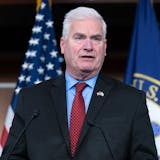Opinion editor’s note: Star Tribune Opinion publishes a mix of national and local commentaries online and in print each day. To contribute, click here.
•••
For many Minnesotans, an article in the Star Tribune last month about rising auto insurance rates highlighted a problem they are already acutely aware of (“Car insurance defies brakes on inflation,” June 13). Many feel they have few ways to resolve the problem, however, other than to drop certain coverages or readjust already strained household budgets.
Auto insurance is required by state law in order for a person to drive lawfully, and given Minnesota’s car-based infrastructure, being able to drive is a necessity for most of us. Since, as the article notes, “the cost of auto insurance is unlikely to fall significantly,” it’s important to ask: Where does that leave Minnesotans who are being priced out of auto insurance with each new rate increase?
In fact, several states — including New Jersey and Hawaii — have worked out a solution, and Minnesota has the opportunity to join them. First proposed in Minnesota in 2023, the Affordable Auto Insurance Program would build on existing state program structures to provide basic liability auto insurance coverage to low-income drivers at affordable rates. This coverage is available to safe drivers who would otherwise struggle to pay the premiums that enable them to drive legally. These drivers avoid the high fines and collateral consequences of driving without insurance, and our communities benefit generally, because everyone on the road is safer when all drivers are insured.
Some context about auto insurance rate-setting is important. There are, as the June 13 article indicated, external factors that can affect the cost of auto insurance. However, auto insurance rates can also be affected by individual factors such as a person’s ZIP code, credit score and/or education level. Notably, none of these factors are connected to or reflective of a person’s driving record. In addition, a factor such as a credit score can weigh against a person simply because they are young and have never had a credit card before, or against a new American citizen for the same reason.
The result is that two drivers in Minnesota with the exact same driving record may be charged drastically different rates for auto insurance. For example, consider: A single, 35-year-old woman with no accidents or tickets on her record, living on the East Side of St. Paul, and who has an excellent credit score, will be charged on average an annual premium of $894 for minimum liability coverage. That’s about $75 a month. The same driver with only a “fair” credit score would face an average annual premium of $1,566, and if their credit score dropped to “poor” — but they maintained a perfect driving record — the average annual premium charged by the 10 largest insurance companies in Minnesota would be $2,943.
The data was acquired by Consumer Federation of America from Quadrant Information Services before the increases cited by the June 13 article, so the East Side driver with a perfect driving record but poor credit would likely now be quoted an annual premium of over $3,000, or over $250 per month. Moreover, the data collected indicates such stark differences in cost were observed across many parts of the state.



